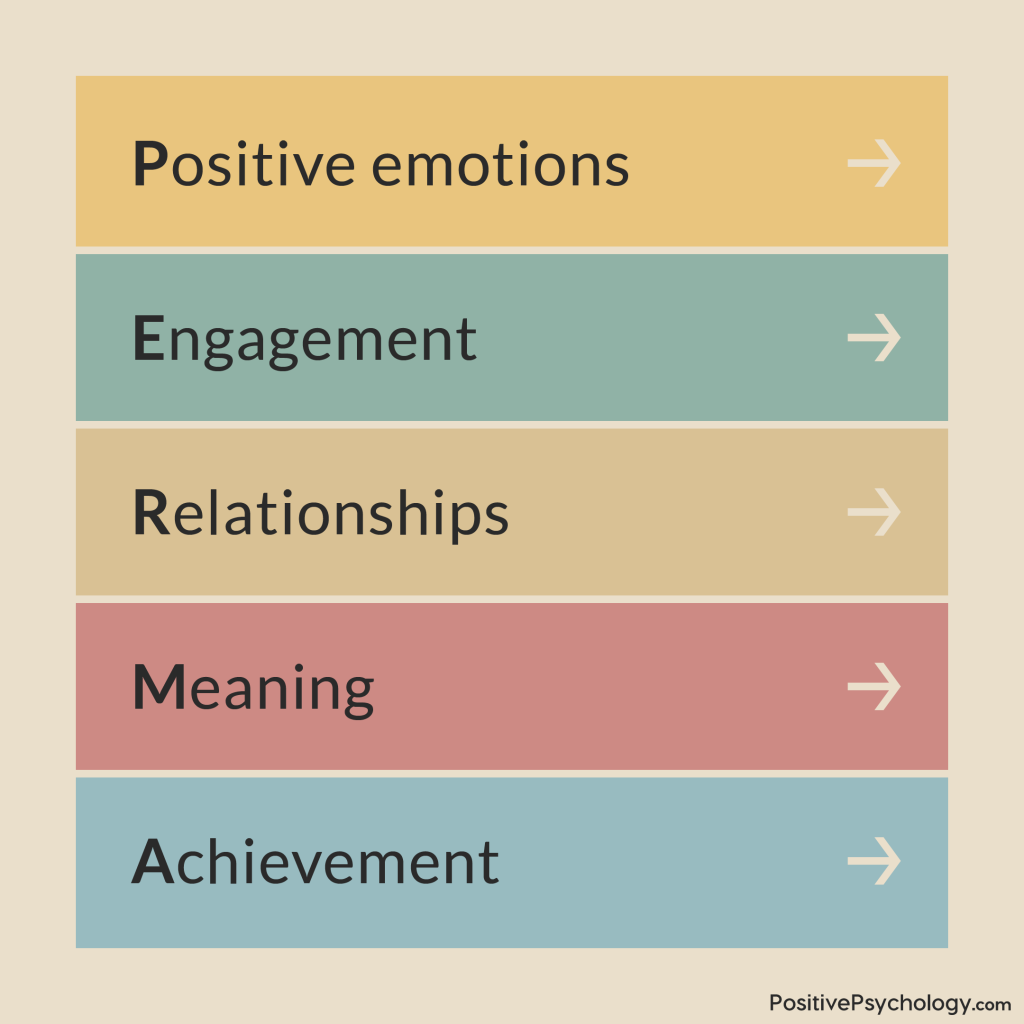Martin Seligman’s Positive Psychology Theory
 Positive psychology is the scientific study of human flourishing. It focuses on individuals’ and communities’ positive aspects and strengths as a path to wellbeing.
Positive psychology is the scientific study of human flourishing. It focuses on individuals’ and communities’ positive aspects and strengths as a path to wellbeing.
As one of the theory’s central proponents, Martin Seligman has helped psychology move away from a sole focus on pathology and illness by supporting clients as they identify and build upon their strengths and set goals to direct meaningful behavior (Seligman, 2011).
This article discusses positive psychology theory as a framework and model for understanding the factors contributing to positive mental health and wellbeing while introducing closely related theories.
Before you continue, we thought you might like to download our three Positive Psychology Exercises for free. These science-based exercises will explore fundamental aspects of positive psychology including strengths, values, and self-compassion, and will give you the tools to enhance the wellbeing of your clients, students, or employees.
This Article Contains:
Martin Seligman’s Positive Psychology Theory
In 1999, psychologist Martin Seligman became president of the US’s largest and most prestigious body of psychologists—the American Psychological Association (APA) (Seligman, 2011).
Having spent much of his early career researching the concept of learned helplessness, Seligman was to introduce positive psychology, a new branch of psychology focusing on the study of positive emotions, character strengths, and building a flourishing life.
Until then, psychology had focused on the problems people faced, what was wrong in their lives, and how it contributed to their depression, anxiety, and lack of mental wellbeing (Seligman, 2011).
While he wasn’t dismissing the rest of psychology–sometimes referred to as the ‘disease model’–he wanted to better understand what makes a life worth living.
After all, Seligman described us humans as innately “bad weather animals,” focusing on what could go wrong in a “world that is full of danger, loss, and injustice,” yet with the potential to learn to focus on creating the good life (Seligman, 2019, p. 209).
Seligman’s initial theory proposed that individuals have three basic psychological needs:
- To feel positive emotion,
- Engage in activities that give life meaning and purpose, and
- Have positive relationships with others.
Two other needs were subsequently added, including
- Finding meaning and fulfillment in what we do and seeking and
- Savoring achievements and accomplishments.
Taken together, their pursuit leads to the development of personal wellbeing and the opportunity to flourish.
Seligman also suggests that individuals have the capacity to develop and strengthen their character strengths, such as grit, resilience, and gratitude, which can further help to enhance their wellbeing and increase happiness (Seligman, 2011).
PERMA – A Positive Psychology Model

It is evidence-based and a valuable and powerful tool for further research and application within therapy and our personal and working lives (Seligman, 2011).
The PERMA model proposes we can break down wellbeing into five key elements: Positive emotions, Engagement, Relationships, Meaning, and Accomplishment.
Each is vital because it can be pursued for its own sake and built upon. When combined, they provide an essential path to flourishing. The individual pursuing these elements becomes more able to deal with life’s challenges. It becomes possible to create more meaningful lives with a powerful positive impact on increasing wellbeing while at the same time reducing psychological distress.
Taking each one in turn (Seligman, 2011, 2019):
- Positive emotions refer to the experience of positive feelings and emotions, such as satisfaction, awe, joy, and contentment
- Engagement relates to our experience of flow and being consumed in an activity and environment
- Relationships refer to the quality and quantity of social connections inside and outside our immediate group
- Meaning brings importance to having a sense of purpose or meaning in life.
- Accomplishment is based on the experience of achievement and progression toward goals.
The PERMA model provides a helpful framework for understanding and measuring psychological wellness. Psychotherapists can use it to help individuals identify areas of their lives where they may lack in wellbeing and work on strategies to increase wellbeing in those areas.
While Seligman’s model did not include ‘health,’ it is now recognized as contributing to overall wellbeing, can be pursued for its own sake, and is measurable. Health can refer to objective wellness, such as being free of disease and illness, adopting healthy lifestyles, and perceived vitality and sufficient energy and mobility to perform daily activities (Allen et al., 2022; Beacham et al., 2020).
As a result, the extended PERMAH model has proven popular and effective, particularly in educational and workplace settings, where it can be predictive of wellness and performance (Allen et al., 2022; Beacham et al., 2020).
4 Other Positive Psychology Theories
The following theories each contribute to the research and application of positive psychology while emphasizing specific elements of the PERMA model:
1. Hope theory
“Hope is defined as the perceived ability to produce pathways to achieve desired goals and to motivate oneself to use those pathways” (Lopez et al., 2021, p. 323).
Hope theory, developed by C.R. Snyder, focuses on the role of ‘hope’ in achieving such goals and overcoming challenges along the way and comprises two components (Lopez et al., 2021):
- Pathways
The individual’s belief in the potential of achieving their goals using various strategies and resources. - Agency
A belief in their ability to act and make things happen.
Individuals high in hope are more likely to set challenging goals, persevere in the face of obstacles, and find alternative paths to achieve their goals (Tomasulo, 2020).
Psychotherapists can use hope theory to help individuals identify and build on their strengths, set achievable goals, and develop coping strategies for overcoming challenges (Lopez et al., 2021).
2. Resilience theory
Different people react to the same challenges and upsetting life events in various ways—some bounce back or find an alternative path while others struggle to adapt—leading to short-term chronic health issues (Neenan, 2018).
“It is estimated that up to 90 percent of us will experience at least one serious traumatic event during our lives,” so it is vital we understand the factors involved in resilience to support clients better or teach them more healthy coping mechanisms (Southwick & Charney, 2018, p. 1).
Resilience theory suggests that it is less about the events surrounding stressful times and trauma and more about how our subjective experience means we experience them (Lopez et al., 2021).
Resilient individuals typically have specific characteristics, such as being able to regulate emotions, able to solve problems effectively, and maintain positive relationships. Such individuals also often have a strong sense of purpose and meaning, which helps them find hope and motivation in difficult times.
Resilience theory has important implications for psychotherapy, as it suggests that helping individuals develop resilience can be crucial in achieving positive outcomes.
Psychotherapists can use it to help clients identify and build on their own strengths, develop coping strategies for managing adversity, and find meaning and purpose in their lives.
Overall, resilience theory emphasizes the importance of personal resources and positive relationships in facilitating positive change and achieving wellbeing (Neenan, 2018).
3. Flow theory
Flow is a mindset people can enter when fully immersed in and enjoying an activity or task. When doing so, they are likely to be highly motivated, productive, creative, and perform at their very best. Flow helps people achieve what they thought was impossible (Csikszentmihalyi, 2009).
As a result, flow theory closely aligns with positive psychology. After all, the second letter of the PERMA model refers to ‘engagement’—that sense of time standing still and a loss of self-consciousness (Seligman, 2011).
According to Mihaly Csikszentmihalyi, flow, or ‘being in the zone’ involves being fully engaged in an activity combined with a state of optimal experience where the individual experiences a sense of enjoyment and purpose (Csikszentmihalyi, 2009).
While we can identify when flow is experienced, we can also create an environment where it is more likely to happen.
Flow occurs when an individual’s skills and abilities match the activity’s challenge. When optimal, the individual can fully engage in a task or environment and experience a sense of enjoyment and accomplishment—along with other positive emotions and improved wellbeing (Csikszentmihalyi, 2009).
As such, flow theory has significant implications for therapy because it emphasizes the importance of finding purpose and meaning through engagement in enjoyable and fulfilling activities.
Helping individuals identify and engage in activities that promote flow can be crucial in achieving positive outcomes. Therapists can help individuals find challenging and rewarding activities, and develop strategies for achieving a state of flow (Riva, Freire, & Bassi, 2016).
4. Strength theory
Positive psychology focuses on strengths rather than weaknesses and encourages individuals to set and work towards meaningful goals.
While we can’t choose our ‘signature strengths,’ we can decide when to use them and how to develop them. They are vital because they make us feel ‘like the real us.’ We feel more engaged, excited, and authentic, and they leave us feeling like the very best version of ourselves.
And these strengths are important to our mental health: identifying and creating opportunities to use strengths has proven effective at lowering depression for up to three and six months (Seligman, 2011).
After all, strengths are not temporary or transient. They endure and are central to who we are and how we think of ourselves. Awareness of our top three to five strengths allows us to be our best selves at home, in education, and in the workplace (Niemiec, 2018).
Therapists can help clients recognize their strengths and understand how and when to use them, promoting improved health, wellbeing, performance, and productivity.
Strengths-based therapy supports clients as they become more aware of their strengths and explore and apply them—encouraging them to become the ‘heroes’ of their own lives (Jones-Smith, 2014).
“Find your strengths and act on them with focused attention, and the world will beat a path to you,” writes psychologist and President of the Strengths-Based Institute, Elsie Jones-Smith (Jones-Smith, 2014, p. 3).
Positive Psychology Theory Research and Applications

After all, “meaning in life is an important variable for human wellbeing” and can be found in what we do, who we are with, and where we are (Lopez et al., 2021, p. 679).
Applied positive psychology offers a practical approach for psychotherapists working with clients to improve their optimal functioning and psychological wellbeing (Boniwell & Tunariu, 2019).
The following three areas are rich and diverse settings for both positive psychology theory research and application:
1. Education
Positive psychology has proven particularly helpful with young people in education. Seligman recognized its importance based on his research, saying that when embedding “positive education into the day, many students and teachers found themselves living it in ways they had not anticipated” (Seligman et al., 2009, p. 306).
2. Workplace
Positive psychology at work typically includes positive organizational psychology, organizational behavior, and organizational scholarship.
The disciplines combine to achieve desirable outcomes for individuals and organizations (Donaldson & Ko, 2010).
Recent and ongoing research confirms that related interventions can improve employee and organizational functioning (Donaldson, Lee, & Donaldson, 2019).
3. Criminology
Positive criminology aims to reduce criminal behavior by focusing on the positives in offenders’ lives and their personal growth. Rather than a single theory–and in the absence of a unifying definition–positive criminology integrates existing models with more recent positive approaches.
Research suggests that finding meaning and fulfillment in life can reduce adolescents’ risk of drug use and crime (Ronel & Elisha, 2010).
There are many other contexts and populations where positive psychology is proving successful. Therapy, in particular, has embraced the theory to move from “diagnosing and treating disorder, maladjustment, suffering, and so on” to build on clients’ existing strengths and to live a life of ‘flourishing’ (Boniwell & Tunariu, 2019, p. 233).
Martin Seligman on positive psychology – Psychology Now
3 Aspects Positive Psychology Is Based On
Positive psychology is the study of what makes life worth living. It focuses on the positive events and influences in life by building upon the following three vital elements (Seligman, 2011; Boniwell & Tunariu, 2019):
1. Positive experiences
The events in our lives that lead to growth and take us further along the path to meaningful goals and fulfillment.
2. Positive states and traits
The positive emotions we experience, like love, gratitude, awe, and compassion, that result from how we perceive the environment in which we find ourselves.
3. Positive institutions
Our lives are continuously and intimately connected with our families, schools, and workplaces. Applying positive principles to entire organizations and institutions can improve individual and collective wellbeing and performance.
As both a theory and an approach, positive psychology has the potential to lead to more fulfilling lives, turn trauma into growth, and develop a more resilient outlook (Seligman, 2011).
Best Resources From PositivePsychology.com
We have many resources available for therapists wishing to use positive psychology theory and interventions with their clients.
Why not download our free positive psychology exercises pack and try out the powerful tools contained within, including:
- The Strengths Wheel
Helps the client become more aware of their strengths and explore ways to optimize and increase their use. - Compassionate Chair Work
This powerful technique can address maladaptive schemas. Clients move between chairs as they converse between different parts of themself.
Other free resources include:
- Reflecting on Three Things
It is vital to remember who we are and are not. This worksheet examines what the client likes about themselves and the relationships that are most important to them. - Life Deviation Scores and Setting Goals
Use this worksheet with your client to focus on their three most important life domains and values and associated goals.
If you’re looking for more science-based ways to help others enhance their wellbeing, this signature collection contains 17 validated positive psychology tools for practitioners. Use them to help others flourish and thrive.
A Take-Home Message
When Martin Seligman became president of the American Psychological Association (APA), he changed the focus of psychology from what was wrong in our lives to how to flourish (Seligman, 2011).
Positive psychology theory focuses on the positive aspects of human life, such as happiness, strengths, and fulfillment, rather than solely on pathology and mental illness. As such, it offers therapists a unique perspective and toolset for helping their clients improve their mental health and overall wellbeing.
As a therapist, incorporating positive psychology into your practice can benefit your clients by helping them to identify and build upon their strengths, set and achieve meaningful goals, and increase their overall wellbeing. It can also enhance your personal fulfillment and satisfaction as a mental health professional by providing a more holistic and proactive approach to mental health care.
Positive psychology interventions are effective in reducing depression, increasing life satisfaction, and enhancing coping skills. Incorporating positive psychology into your practice can help clients build resilience, cultivate gratitude, and find meaning and purpose.
We hope you enjoyed reading this article. Don’t forget to download our three Positive Psychology Exercises for free.
- Allen, K.-A., Furlong, M. J., Vella-Brodrick, D., & Suldo, S. M. (2022). Handbook of positive psychology in schools: Supporting process and Practice. Routledge, Taylor & Francis Group.
- Beacham, A., Brainard, A., Janosy, N., & Reese, J. (2020). A brief evidence-based intervention to enhance workplace well-being and flourishing in health care professionals: Feasibility and pilot outcomes. Journal of Wellness, 2(1), 1–9.
- Boniwell, I., & Tunariu, A. D. (2019). Positive psychology: Theory, research and applications. London: Open University Press.
- Csikszentmihalyi, M. (2009). Flow: The psychology of optimal experience. Harper Row.
- Donaldson, S. I., & Ko, I. (2010). Positive organizational psychology, behavior, and scholarship: A review of the emerging literature and evidence base. The Journal of Positive Psychology, 5(3), 177–191.
- Donaldson, S. I., Lee, J. Y., & Donaldson, S. I. (2019). The Effectiveness of Positive Psychology Interventions in the Workplace: A Theory-Driven Evaluation Approach. In: Van Zyl, L., Rothmann Sr., S. (eds) Theoretical Approaches to Multi-Cultural Positive Psychological Interventions. Springer, 115-159.
- Jones-Smith, E. (2014). Strengths-based therapy: Connecting theory, practice, and skills. Sage.
- Lopez, S. J., Edwards, L. M., & Marques, S. C. (2021). The Oxford Handbook of Positive Psychology. Oxford University Press.
- Neenan, M. (2018). Developing resilience: A cognitive-behavioural approach. Abingdon, Oxon: Routledge.
- Niemiec, R. M. (2018). Character strengths interventions: A field guide for Practitioners. Boston: Hogrefe.
- Riva, E., Freire, T., & Bassi, M. (2016). The Flow Experience in Clinical Settings: Applications in Psychotherapy and Mental Health Rehabilitation. In: Harmat, L., Ørsted Andersen, F., Ullén, F., Wright, J., Sadlo, G. (eds) Flow Experience. Springer (pp. 309-326).
- Ronel, N., & Elisha, E. (2010). A different perspective: Introducing positive criminology. International Journal of Offender Therapy and Comparative Criminology, 55(2), 305–325.
- Seligman, M. E. P., Ernst, R. M., Gillham, J., Reivich, K., & Linkins, M. (2009). Positive education: positive psychology and classroom interventions. Oxford Review of Education, 35(3), 293-311.
- Seligman, M. (2011). Flourish: A new understanding of happiness and well-being and how to achieve them. Nicholas Brealey Publishing.
- Seligman, M. E. (2019). The Hope Circuit: A psychologist’s journey from helplessness to optimism. Nicholas Brealey Publishing.
- Southwick, S. M., & Charney, D. S. (2018). Resilience: The science of mastering life’s greatest challenges. Cambridge University Press.
- Tomasulo, D. (2020). Learned hopefulness: The power of positivity to overcome depression. New Harbinger.
Let us know your thoughts
Read other articles by their category
- Body & Brain (49)
- Coaching & Application (57)
- Compassion (26)
- Counseling (51)
- Emotional Intelligence (24)
- Gratitude (18)
- Grief & Bereavement (21)
- Happiness & SWB (40)
- Meaning & Values (26)
- Meditation (20)
- Mindfulness (45)
- Motivation & Goals (45)
- Optimism & Mindset (34)
- Positive CBT (29)
- Positive Communication (20)
- Positive Education (47)
- Positive Emotions (32)
- Positive Leadership (18)
- Positive Parenting (4)
- Positive Psychology (33)
- Positive Workplace (37)
- Productivity (17)
- Relationships (46)
- Resilience & Coping (36)
- Self Awareness (21)
- Self Esteem (38)
- Strengths & Virtues (32)
- Stress & Burnout Prevention (34)
- Theory & Books (46)
- Therapy Exercises (37)
- Types of Therapy (64)






What our readers think
The book is really impressive which plays significant role in the education arena
I absolutely love this, thank you.
Definitely interested in this as it completes the overall experience of psychological well being. Maybe governments around the world could study this and look at ways to implement it into society.
Hello miss Catarina Lino
how are you ?
I will research positive thinking among students at Mosul University to obtain a master’s degree
I hope your kind person will help me
Currently, I am preparing a scale for positive thinking and I am looking for recent ideas and studies in this field , can you help me anything about positive thinking please.
Hi Mohammed,
Sounds like an interesting project! I think one key construct to keep in mind will be self-efficacy, which regards a student’s belief that they can achieve their desired academic outcomes. You can read more about our dedicated post on the topic here.
Hope this helps!
– Nicole | Community Manager
Thank you very much for your concern miss Nicole
I will care for this area
This was very very entertaining my school made me read it and summarise it and to be frank that summarising was the best 20 minutes of my life. God Bless ya’ll Amen
Interesting article, I might ask for more clarification about the relationship point and how to link that to the field of coaching, me as a coach, is there an example about that?
Thanks
Samar
Hi Samar,
Glad you found the post interesting. I suppose the relevance of this point will depend on what kind of coaching you do! But I think the key point is that a sense of connection with others — whether that be in the workplace, our personal relationships, etc. — is critical for happiness and well-being, both psychologically and physically.
With this understanding in mind, you can point your clients to other resources to strengthen their ability to form healthy relationships, such as by encouraging them to develop their emotional intelligence.
Hope this helps!
– Nicole | Community Manager
Very nice article to understand the concept of positive psychology. Would request you to give more clarity on ” the flow”..
Hello, love the articles. Recently got interested in positive psychology because I got tired of not just being me. Let everything around me define me. Now when I feel the walls closing in I remind myself to, “just be me”. It seems to be working very well.
Thank you so much for this article. I plan to utilize this in the field!
Good